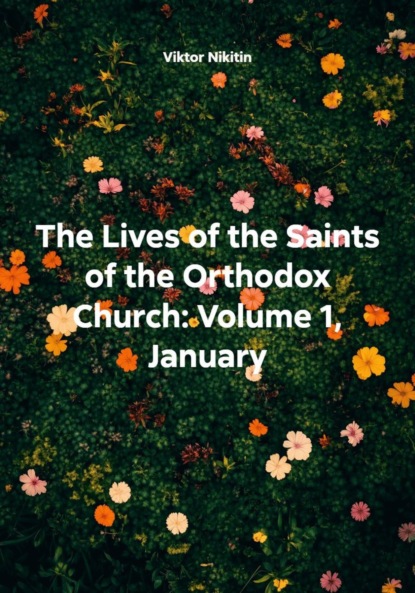The Lives of the Saints of the Orthodox Church: Volume 1, January

- -
- 100%
- +
Saint Peter of Canterbury, monk from St Andrew’s in Rome, one of the first missionaries sent to England (ca. 607):
Peter was a Roman monk from the monastery of St Andrew’s who joined the Gregorian mission led by St Augustine to convert the Anglo-Saxons. He became the first Abbot of Canterbury and helped establish the English Church.
Saint Diman (Dimas, Dima), monk with St Columba and later Bishop of Connor in Ireland (658):
Diman was a monk and disciple of St Columba. Later he served as Bishop of Connor in Ireland, leading the local Church with piety and dedication.
Venerable Wiltrudis, founder of the convent of Bergen near Neuburg in Germany (ca. 976) and its first Abbess (986):
Wiltrudis was a noblewoman who founded the convent of Bergen. She became its first abbess, leading the community in a life of prayer, learning, and charity.
Saint Frederick of Arras, monk at St Vanne and later St Vedast Abbey in Arras (1020):
Frederick was a monk known for his humility and holiness. He served as abbot and was revered for his spiritual guidance and care for the poor.
Martyr Assad the tailor (1218):
Assad was a Christian tailor who suffered martyrdom for his faith, exemplifying the witness of ordinary believers in hostile environments.
New Hieromartyr Romanus, priest of Lacedemonia, at Constantinople, by the sword (1695):
Romanus was a priest martyred in Constantinople during Ottoman rule for steadfastly maintaining Orthodox Christian faith and practice.
Saint Theophan the Recluse, Bishop of Tambov (1894):
Theophan was a renowned Russian bishop, spiritual writer, and mystic. After resigning from his episcopal duties, he lived as a recluse, writing extensively on prayer and spiritual life. His works continue to influence Orthodox spirituality.
Saint Laurence of Chernigov Convent, Wonderworker (1950):
Laurence was an abbess and wonderworker known for her deep faith and miraculous healings. She led the Chernigov Convent with great spiritual insight during tumultuous times.
New Hieromartyr Archpriest Andrew Zimin, his wife Lydia, mother-in-law Domnica, two daughters, and servant Maria, of Ussurisk, Siberia (1919):
Andrew Zimin and his family were martyred for their Orthodox faith during the Russian Civil War period, reflecting the tragic cost of faithfulness in Soviet Russia.
Other Commemorations:
Repose of Schemamonk Nicholas of Valaam (1824): Nicholas was a monastic elder known for his humility and spiritual guidance at the Valaam Monastery.
Repose of Schemamonk Sergius (Yanovsky) (1876), disciple of St. Herman of Alaska: Sergius was a devoted monk and disciple of St Herman, contributing to the growth of Orthodoxy in North America.
* * *
Lives of the Saints Celebrated on January 7
Synaxis of Saint John the Holy Glorious Prophet, Baptist, and Forerunner:
Saint John the Baptist is one of the greatest prophets of the Old Testament and the forerunner of Jesus Christ. He lived a life of strict asceticism in the wilderness, preaching repentance and baptizing those who sought forgiveness of sins. John courageously called out the sins of rulers, including King Herod, which ultimately led to his martyrdom by beheading. He prepared the way for Christ’s ministry and remains a central figure in both Eastern and Western Christian traditions. His feast day honors his role as the bridge between the Old and New Covenants.
Saint Julian the Deacon, of Aegina (391):
Julian was a deacon from the island of Aegina, Greece. Known for his devout service to the Church and his pastoral care, he ministered faithfully during a time of theological turmoil. Julian’s life was marked by humility, charity, and steadfastness in faith, contributing to the spiritual life of the Church in the late 4th century.
Saint Crispin of Pavia, Bishop of Pavia (467):
Crispin was a bishop in the city of Pavia, Italy, during the turbulent times following the collapse of the Western Roman Empire. He worked tirelessly to strengthen the Christian community and combat lingering pagan practices. Known for his pastoral zeal and miracles, Crispin guided his flock with compassion and courage.
Saint Valentine, Abbot and Bishop in Rhaetia (470):
Valentine was an abbot who later became bishop in the region of Rhaetia, located in the eastern Alps (modern Switzerland and parts of Austria). He is remembered for his monastic leadership and missionary work, bringing the light of the Gospel to this mountainous region during the 5th century.
Saint Brannock of Braunton, Hieromonk (6th century):
Brannock was a Celtic monk and priest who lived in the area of Braunton, England. As a hieromonk, he combined the roles of monk and priest, dedicating his life to prayer, asceticism, and pastoral care. Tradition holds that he was instrumental in establishing monastic life in North Devon.
Saint Cedd, Bishop of Lastingham (664):
Cedd was an Anglo-Saxon bishop and missionary who evangelized the kingdom of Essex. He was educated at Lindisfarne and became known for his zeal in preaching and founding churches. Cedd’s episcopal seat was at Lastingham, where he built a monastery. He is revered for his piety and leadership in the early English Church.
Saint Cronan Beg, Bishop of Aendrum in County Down, Ireland (7th century):
Cronan Beg was an Irish bishop known for his holiness and leadership in the Christian community of County Down. His name “Beg” indicates he was likely younger or junior among others named Cronan, a common Irish monastic tradition.
Saint Tillo of Solignac (702):
Tillo was a Frankish monk and abbot at Solignac Abbey in France. He was known for his humility, monastic discipline, and care for the poor. Tillo’s life exemplified the virtues of early medieval monasticism.
Saint Kentigerna, Hermitess of Loch Lomond (734):
Kentigerna was a holy woman who lived as a hermit near Loch Lomond in Scotland. She dedicated herself to prayer, solitude, and the care of others, becoming renowned for her sanctity and miracles.
Saint Emilian (Émilion), Monk at Saujon near Saintes, died as a Hermit (767):
Emilian was a monk who chose the hermit’s life later in his years. Living near Saintes in France, he practiced severe asceticism and prayer, attracting disciples who sought his spiritual guidance.
Blessed Wittikund of Westphalia (804):
Wittikund was a pious man from Westphalia who lived a holy life. Though little is known about him, he was venerated locally for his virtue and sanctity.
Saint Aldric of Le Mans (Aldericus), Bishop of Le Mans (856):
Aldric was a bishop who served the Church in Le Mans, France. He was known for his learning, charitable works, and defense of orthodoxy during difficult times for the Frankish Church.
Saint Reinold, Monk at the Monastery of St Pantaleon in Cologne (960):
Reinold was a monk and later a martyr at St Pantaleon Monastery. He is remembered for his humility, obedience, and dedication to monastic life.
Saint Anastasius of Sens, Archbishop of Sens (977):
Anastasius served as Archbishop in Sens, France, known for his pastoral care, reforms, and defense of the Church’s spiritual and temporal interests.
Saint Feodor I of Russia (Fyodor Ivanovich), Last Rurikid Tsar of Russia (1598):
Feodor I was the last ruler of the Rurik dynasty in Russia. Known for his devout faith and gentle rule, Feodor was often overshadowed by his strong advisors but contributed to the stability of the Russian Orthodox Church during his reign.
New-Martyr Athanasius of Attalia and Smyrna (1700):
Athanasius was a Christian who suffered martyrdom under Ottoman persecution in the cities of Attalia and Smyrna (modern Turkey). He is remembered for his unwavering confession of Christ in the face of death.
New Hieromartyr Alexander Skalsky, Protopresbyter of Alma-Ata (1933):
Alexander was a senior Orthodox priest who was executed by Soviet authorities for continuing to serve the Church during anti-religious persecutions.
New Hieromartyr Paphnutius (Kostin), Hieromonk of Optina Monastery (1938):
Paphnutius was a monk and priest at the famed Optina Monastery in Russia. He was arrested and executed for his faith during the Stalinist purges.
New Hieromartyr Basil, Priest (1939):
Basil was an Orthodox priest martyred during the Soviet persecutions for refusing to renounce his ministry and faith.
Martyr John (1940):
John was a Christian who suffered martyrdom during the early 20th-century persecutions in the Soviet Union, steadfast to his faith until death.
Martyr John (1942):
Another martyr named John, also killed for his Christian faith during the oppressive Soviet regime, exemplifying the courage of modern martyrs.
Other Commemorations:
The Miracle of Saint John the Baptist in Chios (1740):
This event commemorates a miraculous occurrence attributed to the intercession of Saint John the Baptist on the island of Chios, Greece. The miracle reinforced local faith and devotion to the Forerunner.
* * *
Lives of the Saints Celebrated on January 8
Prophet Shemaiah (10th century BC):
Shemaiah was a prophet of Israel during the time of King Rehoboam. Known for his role in advising the king and the people, Shemaiah counseled against rebellion and urged unity among the tribes of Israel. His prophetic messages, recorded in the Old Testament, emphasized obedience to God and peaceful coexistence.
Martyrs Julian and his wife Basilissa, with Marcionilla and her son Celsus, Anthony, Anastasius, seven children and twenty soldiers, at Antinoe in Egypt (283-305):
This large group of martyrs suffered under the persecutions of Emperor Diocletian. Julian and Basilissa were a devout Christian couple who dedicated themselves to prayer and charity. They, along with their family members and companions, faced torture and death for refusing to renounce their faith. Their steadfastness inspired many in Egypt and beyond.
Hieromartyr Carterius of Caesarea in Cappadocia (304):
Carterius was a priest in Caesarea who suffered martyrdom during the early 4th-century persecutions. He was known for his zeal in preaching the Gospel and assisting the faithful under threat, ultimately giving his life by the sword for Christ.
Saint Elias the Wonderworker, of Egypt (4th century):
Elias was a renowned Egyptian monk and wonderworker known for his miracles and healing. His life was marked by asceticism and deep prayer, inspiring many in the monastic communities of Egypt.
Hieromartyr Theophilus the Deacon, and Martyr Helladius, in Libya (4th century):
Theophilus served as a deacon in Libya, assisting the Church during difficult times of persecution. Alongside Helladius, he suffered martyrdom for their unyielding faith and service to the Christian community.
Saint Atticus of Constantinople, Patriarch of Constantinople (425):
Atticus was a wise and just patriarch who guided the Church of Constantinople through theological controversies and social challenges. Known for his defense of orthodoxy and pastoral care, he worked to strengthen the faith of his flock.
Righteous Domnica of Constantinople (ca. 474):
Domnica was a devout Christian woman living in Constantinople, known for her piety, charitable works, and commitment to prayer. She became a model of Christian virtue for the faithful in the capital.
Venerable Agathon of Egypt, monk (5th century):
Agathon was a monk who lived a life of asceticism and prayer in the Egyptian desert. His example of humility and dedication contributed to the flourishing of early Christian monasticism.
Venerable Theodore of Constantinople, founder and abbot of the Monastery of Chora (ca. 595):
Theodore established the Monastery of Chora, which became a significant spiritual center in Constantinople. As abbot, he guided many monks and laity, emphasizing prayer, charity, and orthodoxy.
Venerable George the Chozebite, Abbot (7th century):
George was abbot of the Monastery of Chozeba near Jerusalem, known for his strict monastic discipline and miracles. His leadership and holiness attracted many disciples.
Saint Cyrus of Constantinople, Patriarch of Constantinople (714):
Cyrus led the Church of Constantinople during turbulent times, maintaining orthodoxy against heresies and political challenges. His tenure is remembered for pastoral care and firmness in faith.
Martyr Abo of Tiflis, the Perfumer, of Baghdad, at Tbilisi, Georgia (786):
Abo was a convert from Islam who became a devout Christian and was martyred in Tbilisi for publicly professing his faith. He is celebrated for his courage and dedication to Christ despite great personal risk.
Saint Emilian the Confessor, Bishop of Cyzicus (820):
Emilian defended the Church against iconoclasm and suffered for upholding the veneration of holy icons. His confessor title reflects his endurance of persecution without renouncing orthodoxy.
Saint Patiens, fourth Bishop of Metz (2nd century):
Patiens was an early bishop in Gaul who helped establish the Church in the region, known for his pastoral care and defense of Christian doctrine.
Hieromartyr Lucian the "Apostle of Beauvais", and martyrs Maximian and Julian, in Beauvais (290):
Lucian was a bishop and missionary in northern France, martyred alongside companions Maximian and Julian for preaching the Gospel amidst Roman persecution.
Hieromartyr Eugenian of Autun, Bishop of Autun, defender of Orthodoxy against Arianism (4th century):
Eugenian was a staunch defender of the true faith during the rise of Arianism. His courage in teaching orthodox doctrine led to his martyrdom.
Saint Severinus of Noricum, monk of Gottweig Abbey, enlightener of Noricum Ripensis (482):
Severinus evangelized the region of Noricum (modern Austria), founded monasteries, and assisted refugees during the fall of the Roman Empire.
Saint Ergnad (Ercnacta), nun (5th century):
Ergnad was a holy nun noted for her ascetic life and dedication to prayer, inspiring many women in her community.
Saint Maximus of Pavia, Bishop of Pavia (511):
Maximus was a learned bishop who guided his flock through challenging times with wisdom and piety.
Saint Frodobert, monk at Luxeuil in France, founder of the monastery of Moutier-la-Celle near Troyes (673):
Frodobert was a monk and abbot who expanded monastic life and Christian teaching in France.
Saint Erhard of Regensburg, Bishop of Regensburg (Bavaria) (ca. 686):
Erhard was a missionary bishop who spread Christianity in Bavaria, remembered for his miracles and pastoral zeal.
Saint Albert of Cashel, English laborer in Ireland and Bavaria (7th century):
Albert was a humble laborer who lived a holy life of service in Ireland and Bavaria, inspiring the faithful by his example.
Holy Virgin Gudula, patroness of Brussels in Belgium (712):
Gudula was a devout Christian woman known for her charity and prayer, becoming the patron saint of Brussels.
Saint Pega, anchoress in the ancient Anglo-Saxon kingdom of Mercia (719):
Pega lived a life of solitude and prayer, renowned for her holiness and miracles.
Saint Garibaldus (Gaubald), first Bishop of Regensburg (762):
Garibaldus was the pioneering bishop who established the Church in Regensburg, guiding its early development.
Saint Æthelhelm (Athelm), first Bishop of Wells, later Archbishop of Canterbury (926):
Athelm was an important English church leader who oversaw ecclesiastical reforms and growth.
Saint Wulfsige III (Wulsin), monk, Abbot of Westminster (980), Bishop of Sherborne (993), died 1002:
Wulfsige was known for his monastic leadership and episcopal care, contributing to English Church stability.
Saint Gregory of Ochrid, Bishop of Moesia (1012):
Gregory led the Church in Moesia with zeal, defending orthodoxy and strengthening Christian communities.
Venerable Gregory, Wonderworker of the Kiev Caves (1093):
Gregory was a monk of the Kiev Caves, famed for miracles and deep spiritual insight.
Venerable Gregory the Hermit of the Kiev Caves (14th century):
Gregory lived as a recluse in the caves, devoted to prayer and asceticism.
Venerable Macarius (Makris) of Vatopedi (Mt. Athos) and Pantocratoros Monastery (Constantinople), Abbot (1430):
Конец ознакомительного фрагмента.
Текст предоставлен ООО «Литрес».
Прочитайте эту книгу целиком, купив полную легальную версию на Литрес.
Безопасно оплатить книгу можно банковской картой Visa, MasterCard, Maestro, со счета мобильного телефона, с платежного терминала, в салоне МТС или Связной, через PayPal, WebMoney, Яндекс.Деньги, QIWI Кошелек, бонусными картами или другим удобным Вам способом.





